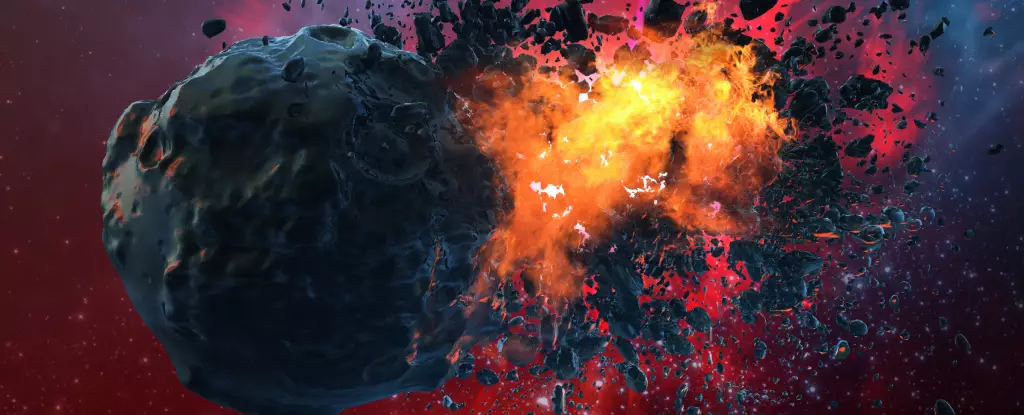The prospect of an asteroid colliding with Earth can evoke feelings of dread, yet as our understanding of these celestial objects grows, so too does our preparedness to confront such existential threats. Recently, scientists have brought attention to a specific asteroid known as 2024 YR4, which, although highly unlikely to collide with our planet, has raised significant concern due to its predicted trajectory. As the likelihood of a potential impact on December 22, 2032, has now reached 3.1%, it is imperative to evaluate humanity’s readiness and response strategies for such events.
The notion of an asteroid capable of erasing a city raises alarm bells among scientists and the general public alike. While a 3.1% chance might seem negligible, the complexities involved in predicting asteroid trajectories can lead to fluctuating probabilities. Richard Moissl of the European Space Agency advises against panic, indicating that such probabilities are subject to change as astronomers refine their models and gather more data. As we strive to comprehend these celestial phenomena, it is critical to foster public awareness of both the risks posed by asteroids and the advancements in our ability to avert them.
Thanks to ongoing technological advancements, humanity is not entirely defenseless against potential asteroid strikes. Some of the most promising strategies involve non-destructive methods that could alter an asteroid’s course without causing devastating fragmentation. One well-known strategy is NASA’s Double Asteroid Redirection Test (DART), which successfully impacted the Dimorphos asteroid to demonstrate that an asteroid’s trajectory could indeed be altered. This landmark achievement underscores the growing capabilities of our space agencies.
Among other non-invasive techniques, the idea of deploying a “gravity tractor” has garnered attention. This method requires a spacecraft to orbit near an asteroid, leveraging its gravitational pull to gradually change the asteroid’s path. Similarly, the use of ion thrusters to emit a constant stream of ions aims to nudge asteroids off their collision course—a subtle approach that hinges on early intervention.
When considering alternatives, the discussion inevitably shifts toward more aggressive measures, such as nuclear interventions. Popularized by cinematic representations like the 1998 film “Armageddon,” the concept of detonating a nuclear bomb near an asteroid has been explored in scientific contexts. Research indicates that a nuclear blast could effectively vaporize portions of an asteroid’s surface, creating a thrust in the opposite direction. However, this option is fraught with challenges, including the risk of generating debris that could still jeopardize Earth.
Furthermore, various ethical and legal implications surround the use of nuclear materials in space, leading many experts to categorize this option as a last resort. Such drastic measures are, however, not without merit, particularly in cases involving large asteroids reminiscent of those that have historically caused mass extinctions.
In addition to the aforementioned methods, innovative approaches are continually being investigated. For instance, scientists have proposed employing high-powered lasers to vaporize parts of an asteroid, potentially altering its trajectory too. While experiments suggest this idea holds promise, it remains outside the realm of primary strategies currently being developed.
What stands out in these discussions is not merely our growing list of potential strategies but also the insight that rapid response is vital. Moissl emphasizes that the critical factor will be our planet’s ability to coordinate and take decisive action. This coordination will necessitate strong leadership among global powers because the responsibility of deciding which strategy to pursue will likely rest with national leaders.
Beyond potential deflection strategies, we also must confront the implications of an anticipated asteroid strike. In the unlikely event of a confirmed impact, our best line of defense may lie in meticulous preparedness, including evacuation protocols for vulnerable areas. Moissl assures the public that, with seven and a half years available for preparation, a concerted effort can significantly bolster our response capabilities.
However, amidst the data and defensive measures, acknowledgment of the overarching 97% possibility that the asteroid will miss Earth serves as a reminder of the importance of measured responses. With rigorous monitoring and research, humanity’s understanding of these cosmic threats continues to improve, ultimately enabling us to act with greater confidence and foresight.
When faced with potential asteroid threats, it is crucial to strike a balance between cautious vigilance and proactive preparation. Through advancing technologies and global collaboration, humanity can pursue an effective path toward planetary defense, transforming fear into readiness.


Leave a Reply